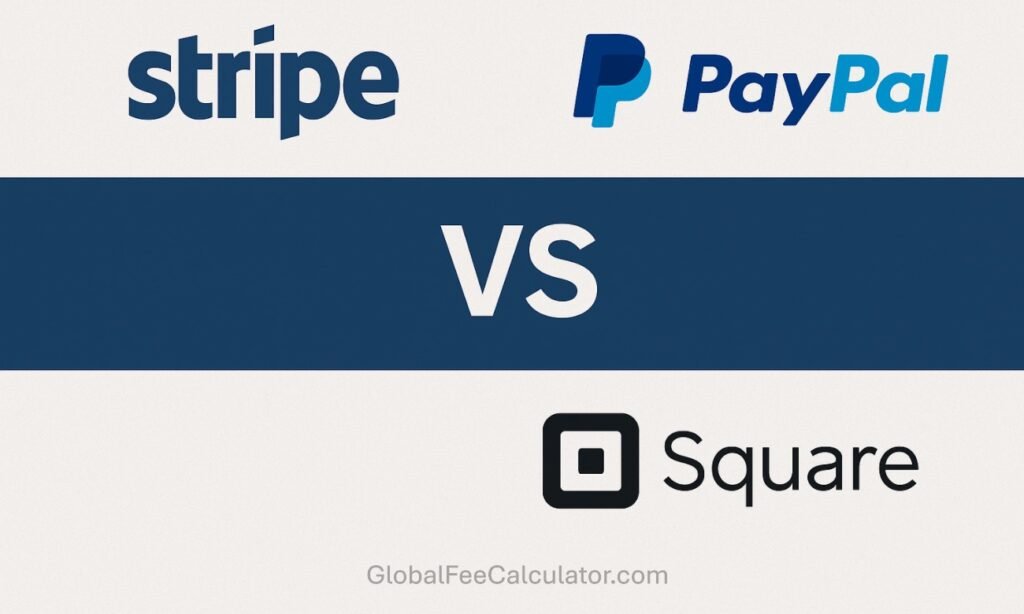Choosing the right payment processor is critical for businesses aiming to minimize costs while maximizing efficiency. For startups, e-commerce giants, and brick-and-mortar stores alike, even a 0.5% difference in transaction fees can translate to thousands saved annually. Stripe, PayPal, and Square dominate the payment processing landscape, but their fee structures vary widely depending on use cases like sales volume, international transactions, and business models. In this deep dive, we’ll compare Stripe vs PayPal vs Square fees, identify the cheapest payment processor, and break down Square vs Stripe pricing to help you make an informed decision—and potentially save big.
Table of Contents
TogglePayment Processor Overview
Before diving into fees, let’s outline each platform’s strengths:
Stripe: Developer-friendly, ideal for online businesses, subscriptions, and global sales.
PayPal: A household name with broad consumer trust, suited for small businesses and freelancers.
Square: Tailored for in-person and omnichannel retail, with POS hardware integrations.
While all three accept major credit cards and digital wallets, their pricing models cater to different audiences. Let’s dissect their fees.
Fee Structures: Breaking Down Costs
1. Stripe Fees
Stripe’s pricing is straightforward but rewards scalability:
Standard Transaction Fee: 2.9% + $0.30 per online transaction.
In-Person Payments: 2.7% + $0.30 (using Stripe Terminal).
International/Currency Conversion: +1% for cross-border transactions; +1% if currency conversion is needed.
Chargebacks: $15 per dispute (waived if resolved in your favor).
Volume Discounts: Custom pricing for businesses processing over $250,000/year.
Where Stripe Wins:
High-volume businesses save with negotiated rates.
Global sales benefit from multi-currency support and lower conversion fees than PayPal.
Subscription billing has no added fees, unlike PayPal’s $10/month for recurring payments.
2. PayPal Fees
PayPal’s fees are competitive but come with caveats:
Standard Transaction Fee: 3.49% + $0.49 per online transaction (U.S.).
In-Person Payments: 2.29% + $0.09 via QR codes.
International Sales: 4.5% + fixed fee for cross-border transactions.
Chargebacks: $20 per dispute (higher than Stripe and Square).
Recurring Payments: Requires PayPal Pro ($30/month) for advanced subscription tools.
Where PayPal Wins:
Micropayments: Custom rates for transactions under 10(e.g.,510(e.g.,50.05).
Small sellers benefit from no monthly fees (unless using Pro).
3. Square Fees
Square shines for in-person sales but has nuances:
Online Transactions: 2.9% + $0.30 (same as Stripe).
In-Person Payments: 2.6% + $0.10 (cheapest for retail).
International Sales: 3.5% + fixed fee (no currency conversion unless using Square Balance).
Chargebacks: $15 per dispute.
Advanced Features: $60/month for Square for Retail (inventory management, loyalty programs).
Where Square Wins:
Retailers save on in-person rates.
Startups get free POS hardware with Square Reader.
Head-to-Head Comparison
| Scenario | Stripe | PayPal | Square |
|---|---|---|---|
| Online Transaction Fee | 2.9% + $0.30 | 3.49% + $0.49 | 2.9% + $0.30 |
| In-Person Fee | 2.7% + $0.30 | 2.29% + $0.09 | 2.6% + $0.10 |
| International Surcharge | +1% | +4.5% | +3.5% |
| Subscription Tools | Free | $30/month (Pro) | $60/month (Retail) |
| Best For | Global, high-volume | Small sellers | Retail, omnichannel |
When Is Stripe the Cheapest Payment Processor?
High-Volume Sales: Businesses processing 250k+ annually may qualify for Stripe’s custom rates, which can drop below below 2.5% + $0.30 per charge
Global Expansion: Stripe supports 135+ currencies and charges just 1% for conversions, compared to PayPal’s 4.5% cross-border fee.
Subscription Models: No monthly fees for recurring billing, unlike PayPal Pro or Square’s Retail plan.
Example: A SaaS company with 500k/year in global sales would save 12,000 annually with Stripe vs PayPal (factoring in PayPal’s higher international fees and subscription costs).
Square vs Stripe Pricing: Which Is Better for Startups?
In-Person Sales: Square’s 2.6% + 0.10edgesoutStripe’s2.70.10edgesoutStripe’s2.70.30.
Online Sales: Tie at 2.9% + $0.30, but Stripe’s APIs offer more customization.
Scalability: Stripe’s lack of monthly fees and volume discounts make it cheaper as you grow.
PayPal’s Hidden Costs
While PayPal’s standard rates seem competitive, watch for:
Chargeback Penalties: 20vsStripe/Square’s20vsStripe/Square’s15.
Currency Conversion: 4.5% vs Stripe’s 1%.
Withdrawal Fees: Free for U.S. accounts, but international banks may incur fees.
The Verdict: Which Payment Processor Saves You Money?
Stripe: Best for high-volume, global, or subscription-based businesses.
PayPal: Ideal for small sellers prioritizing buyer trust.
Square: Top choice for retailers with in-person sales.
Try Our Fee Calculator: [Your Affiliate Link] to compare your projected costs across platforms.
Final Recommendation on Stripe vs PayPal vs Square
If you’re a scaling business with global ambitions or recurring revenue, Stripe consistently offers the lowest fees and flexibility. Ready to get started? [Sign up for Stripe here] (affiliate link) and leverage their developer tools to optimize your payment flow.


